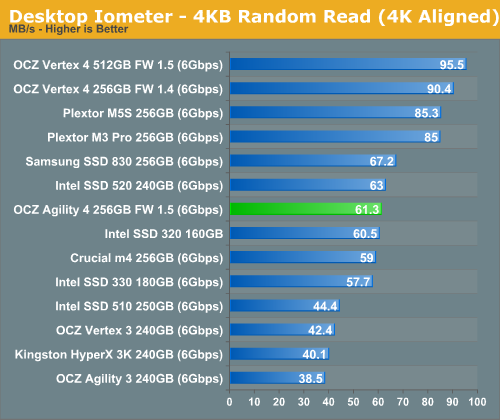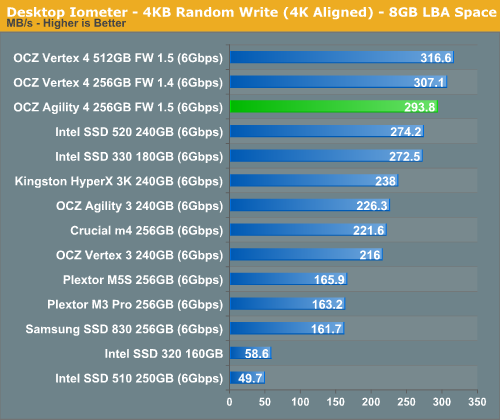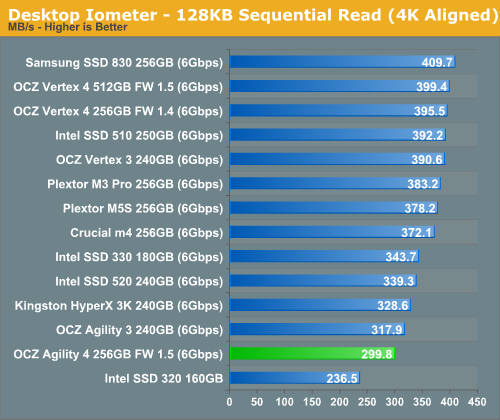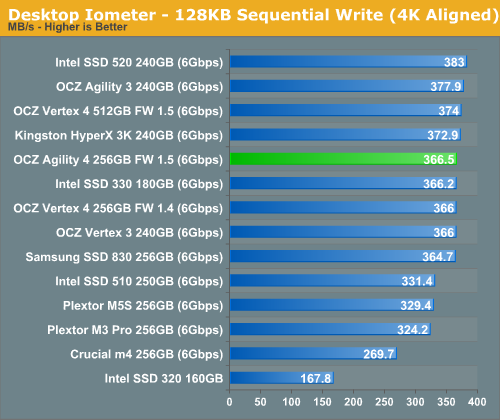OCZ Agility 4 (256GB) Review
by Kristian Vättö on September 1, 2012 1:00 PM ESTRandom Read/Write Speed
The four corners of SSD performance are as follows: random read, random write, sequential read and sequential write speed. Random accesses are generally small in size, while sequential accesses tend to be larger and thus we have the four Iometer tests we use in all of our reviews. Our first test writes 4KB in a completely random pattern over an 8GB space of the drive to simulate the sort of random access that you'd see on an OS drive (even this is more stressful than a normal desktop user would see).
We perform three concurrent IOs and run the test for 3 minutes. The results reported are in average MB/s over the entire time. We use both standard pseudo randomly generated data for each write as well as fully random data to show you both the maximum and minimum performance offered by SandForce based drives in these tests. The average performance of SF drives will likely be somewhere in between the two values for each drive you see in the graphs. For an understanding of why this matters, read our original SandForce article.

The performance difference between synchronous and asynchronous NAND is pretty clear here. At queue depth of 1, 4KB random reads are heavily dependent on the speed of NAND. Queue depth of 1 means that only one I/O request is sent at a time, which means the controller can only read from one NAND at a time (write combining helps work around this issue). Increasing queue depth allows the controller to read from multiple NAND dies at the same time, which leads to better performance especially when dealing with slower NAND (you can always hide latency with parallelism). Our 4KB random read test happens at queue depth of 3, which gives the Agility 4 some breathing room but it's still enough to show the difference between asynchronous and synchronous NAND.
Note that with bigger transfers, this is not as big issue because they are usually broken into smaller pieces and striped across multiple NAND dies, again allowing the controller to utilize multiple NAND dies simultaneously. Obviously, you need a fast controller and firmware to really notice the impact of slower NAND, which is exactly what the Everest 2 is.


Random write performance isn't impacted as much by the slower NAND, not even at queue depth of 1. When reading data from an SSD, the data has to be fetched from the actual NAND, which can create a bottleneck with slower NAND. Write IOs, on the other hand, can be cached to much faster DRAM before written to NAND. Today's SSDs have fairly big caches so the NAND will have plenty of time to catch up. Of course, ultimately you will hit a wall and the NAND becomes a bottleneck. After our 20 minute torture session (4KB random writes at queue depth of 32 and 100% LBA space ran on a full drive), the Agility 4 was writing at 19.1MB/s, while 256GB Vertex 4 was chugging along at 28.4MB/s.
Sequential Read/Write Speed
To measure sequential performance we ran a one minute long 128KB sequential test over the entire span of the drive at a queue depth of 1. The results reported are in average MB/s over the entire test length.

Sequential read performance is slower compared to Vertex 4 so we are definitely being limited by NAND here.

Sequential write speed is in fact on-par with Vertex 4. The bottleneck is obviously something else than NAND because quite a few drives are hitting the same speeds. We're likely running into the limits of how much parallelism you can extract from a low queue depth 128KB sequential transfer.










41 Comments
View All Comments
Qapa - Sunday, September 2, 2012 - link
Yes, please do it :)Italic / special background color / anything
(just also indicate that at the start of the article)
Mr Perfect - Thursday, September 6, 2012 - link
Yes, good idea. I generally assume most of the text on the performance pages of a SSD article is boilerplate and just skip it. I was surprised to find unique bits of information on the performance pages.Death666Angel - Saturday, September 1, 2012 - link
Thanks for the review! I'm kinda missing the power consumption part though. :DDeath666Angel - Saturday, September 1, 2012 - link
Nevermind, just saw the other comment about it. Hope you can add it in the future though. :)ajp_anton - Sunday, September 2, 2012 - link
"Pricing is very close to the Vertex 4"I'd say. It's identical, except for the 120GB one. With the Ag/Vx 3, the Agility is actually more expensive at that size.
Are you sure you got that table right?
CaedenV - Sunday, September 2, 2012 - link
All the sudden I am not so sad about using the Agility 3's for my system drive. Agility 4 came out shortly after I purchased my first Agility 3 and I was kicking myself, but now it looks like it was not too bad of a move.SanX - Sunday, September 2, 2012 - link
"But at normal prices, the m4 or 830 for a little more would be a much better purchase..."830 consumes 2 times more - hell 5+ Watts - then all others in the market
claysm - Monday, September 3, 2012 - link
But is 5 watts really that much? 830 ftw even if it's 15 watts more.erple2 - Monday, September 3, 2012 - link
In a desktop environment, no, it doesn't make a significant difference. However, the mobile market is where every extra watt will make a significant difference in battery life. I've been considering buying an ssd for my laptop for a while, and the high power usage in the 830 is why I've taken that one out of the running.Wanou - Monday, September 3, 2012 - link
back in 2000, OCZ was known for their bullshit marketing selling DRAM.Then, they sold PSUs.
I bought one for myself... Guess what ? It was bullshit: Expensive for no more than a cheap crappy PSU in a classy box.
When OCZ started making SSDs, I thought:" I will never buy one from them".
But the Vertex 1 and after, the Vertex 2 looks so good, I bought one. And another. And another for my mother, another for my dad...
They all worked great and are still working !
So, I decided to get every PC where I'm working with a vertex 2 SSD. We are using huge mailboxes (Several Gb). So it was damn fast.
May I say that It was just AFTER OCZ switched silently to 25nm ?
Two friends of mine bought also one VTXE.
When the first one bricked, it was bad luck
The second started BSO before dying. Bad karma.
The third locked Windows and was not detected on reboot.
As for the 4th, the 5th, the 6th, the 7th...
Each time, the bricked VERTEX 2E SSDs were replaced by Agility drives.
I've switched to Samsung 830. So far, with more than 20 SSDs installed during the last 4 month, I've not suffered from ONE defect.
Today, i'm waiting for the replacement SSDs for my 8th in row FAILED OCZ VERTEX2.
One product can fail.
But when you get 8 failed products on 16 products coming from 2 batches and 2 different sizes (90/120Gb), you should take care and stop using the -still working- remaining ones.
And never buy OCZ Again.